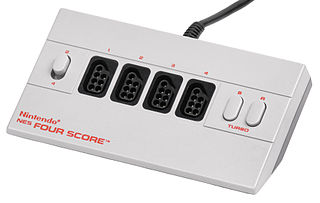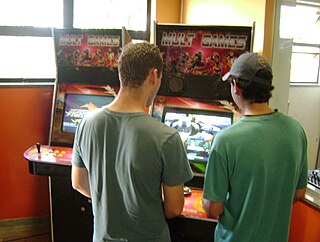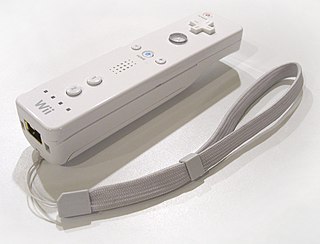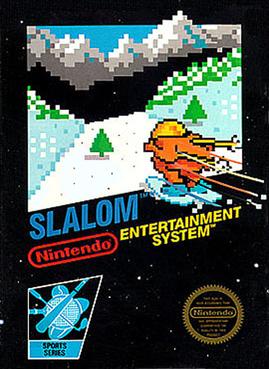
The TurboGrafx-16, known as the PC Engine outside North America, is a home video game console designed by Hudson Soft and sold by NEC Home Electronics. It was the first console marketed in the fourth generation, commonly known as the 16-bit era, though the console has an 8-bit central processing unit (CPU) coupled with a 16-bit graphics processor. It was released in Japan in 1987 and in North America in 1989. In Europe, the console is known as the PC Engine, after the Japanese model was imported and distributed in the United Kingdom and France from 1988. In Japan, the system was launched as a competitor to the Famicom, but the delayed United States release meant that it ended up competing with the Sega Genesis and later the Super NES.

A game controller, gaming controller, or simply controller, is an input device or input/output device used with video games or entertainment systems to provide input to a video game. Input devices that have been classified as game controllers include keyboards, mouses, gamepads, and joysticks, as well as special purpose devices, such as steering wheels for driving games and light guns for shooting games. Controllers designs have evolved to include directional pads, multiple buttons, analog sticks, joysticks, motion detection, touch screens and a plethora of other features.

The Super Scope, known as the Nintendo Scope in Europe and Australia, is a first party light gun peripheral for the Super Nintendo Entertainment System. The successor to the NES Zapper, the Super Scope was released in North America and the PAL region in 1992, followed by a limited release in Japan in 1993 due to a lack of consumer demand. The peripheral consists of two devices: the wireless light gun itself, called the "Transmitter", and a "Receiver" that connects to the second controller port of the Super NES console. The Transmitter has two action buttons, a pause button, a power switch and is powered by six AA batteries.

A gamepad is a type of video game controller held in two hands, where the fingers are used to provide input. They are typically the main input device for video game consoles.

The NES Four Score is a multitap accessory created by Nintendo in 1990 for the Nintendo Entertainment System. Select games can utilize it to enable up to four-player gameplay. The NES Four Score is similar to the previously introduced NES Satellite, a device that allows four players to connect to the NES and extends the range using infrared wireless communication.

An arcade cabinet, also known as an arcade machine or a coin-op cabinet or coin-op machine, is the housing within which an arcade game's electronic hardware resides. Most cabinets designed since the mid-1980s conform to the Japanese Amusement Machine Manufacturers Association (JAMMA) wiring standard. Some include additional connectors for features not included in the standard.

Nekketsu Kōha Kunio-kun, released as Renegade in the West, is a beat 'em up video game developed by Technōs Japan and distributed by Taito for the arcades in 1986. In the original Japanese version Nekketsu Kōha Kunio-kun, the game revolves around a high-school delinquent named Kunio-kun who must stand up against a series of rival gangs frequently targeting his classmate Hiroshi. In the Western version Renegade, the player controls a street brawler who must face four different gangs in order to rescue his girlfriend being held captive by a mob boss.

An analog stick, also known as control stick, joystick or thumbstick, is an input device for a controller that is used for two-dimensional input. An analog stick is a variation of a joystick, consisting of a protrusion from the controller; input is based on the position of this protrusion in relation to the default "center" position. While digital sticks rely on single electrical connections for movement, analog sticks use continuous electrical activity running through potentiometers to measure the exact position of the stick within its full range of motion. The analog stick has greatly overtaken the D-pad in both prominence and usage in console video games.
The Virtual Console was a line of downloadable video games for Nintendo's Wii and Wii U home video game consoles and the Nintendo 3DS family of systems.
A video game accessory is a distinct piece of hardware that is required to use a video game console, or one that enriches the video game's play experience. Essentially, video game accessories are everything except the console itself, such as controllers, memory, power adapters (AC), and audio/visual cables. Most video game consoles come with the accessories required to play games out of the box : one A/V cable, one AC cable, and a controller. Memory is usually the most required accessory outside of these, as game data cannot be saved to compact discs. The companies that manufacture video game consoles also make these accessories for replacement purposes as well as improving the overall experience. There is an entire industry of companies that create accessories for consoles as well, called third-party companies. The prices are often lower than those made by the maker of the console (first-party). This is usually achieved by avoiding licensing or using cheaper materials. For the mobile systems like the PlayStation Portable and Game Boy iterations, there are many accessories to make them more usable in mobile environments, such as mobile chargers, lighting to improve visibility, and cases to both protect and help organize the collection of system peripherals to. Newer accessories include many home-made things like mod chips to bypass manufacturing protection or homemade software.

The Dual Analog Controller is Sony's first handheld analog controller for the PlayStation, and the predecessor to the DualShock. Its first official analog controller was the PlayStation Analog Joystick (SCPH-1110).

Forgotten Worlds, titled Lost Worlds in Japan, is a side-scrolling shooter video game by Capcom, originally released as a coin-operated arcade game in 1988. It is notable for being the first title released by Capcom for their CP System arcade game hardware.

The Wii Remote, also known colloquially as the Wiimote, is the primary game controller for Nintendo's Wii home video game console. An essential capability of the Wii Remote is its motion sensing capability, which allows the user to interact with and manipulate items on screen via motion sensing, gesture recognition, and pointing which is used for the console, using accelerometer and optical sensor technology. It is expandable by adding attachments. The attachment bundled with the Wii console is the Nunchuk, which complements the Wii Remote by providing functions similar to those in gamepad controllers. Some other attachments include the Classic Controller, Wii Zapper, and the Wii Wheel, which has originally been used for the racing game, Mario Kart Wii.

The Nintendo 64 controller is the standard game controller for the Nintendo 64 home video game console. Manufactured and released by Nintendo on June 23, 1996, in Japan, in September 29, 1996 in North America, and March 1, 1997 in Europe, it is the successor to the Super Nintendo controller and is designed in an "M" shape and features 10 buttons, one analog "Control Stick" and a directional pad.

Slalom, originally released as VS. Slalom, is a skiing sports video game developed by Rare and published by Nintendo in 1986 for the Nintendo VS. System in arcades. It was then released for the Nintendo Entertainment System in North America in March 1987 and in Europe later that year. The player races in a series of downhill slalom skiing runs while navigating past flags and obstacles before time expires. It was developed by Tim and Chris Stamper and its music was composed by David Wise.

The Nintendo Entertainment System (NES) is an 8-bit third-generation home video game console produced by Nintendo. It was first released in Japan in 1983 as the Family Computer (FC), commonly referred to as Famicom. It was redesigned to become the NES, which was released in American test markets on October 18, 1985, and was soon fully launched in North America and other countries.

The Atari CX40 joystick was the first widely used cross-platform game controller. The original CX10 was released with the Atari Video Computer System in 1977 and became the primary input device for most games on the platform. The CX10 was replaced after a year by the simpler and less expensive CX40. The addition of the Atari joystick port to other platforms cemented its popularity. It was the standard for the Atari 8-bit family of home computers and was compatible with the VIC-20, Commodore 64, Commodore 128, MSX, and later the Atari ST and Amiga. Third-party adapters allowed it to be used on other systems, such as the Apple II, TI-99/4A, and the ZX Spectrum.

The Xbox Adaptive Controller (XAC) is a video game controller designed by Microsoft for Windows PCs and the Xbox One and Xbox Series X/S video game consoles. The controller was designed for people with disabilities to help make user input for video games more accessible.
















